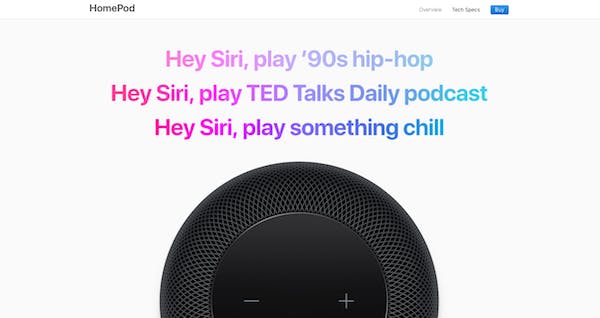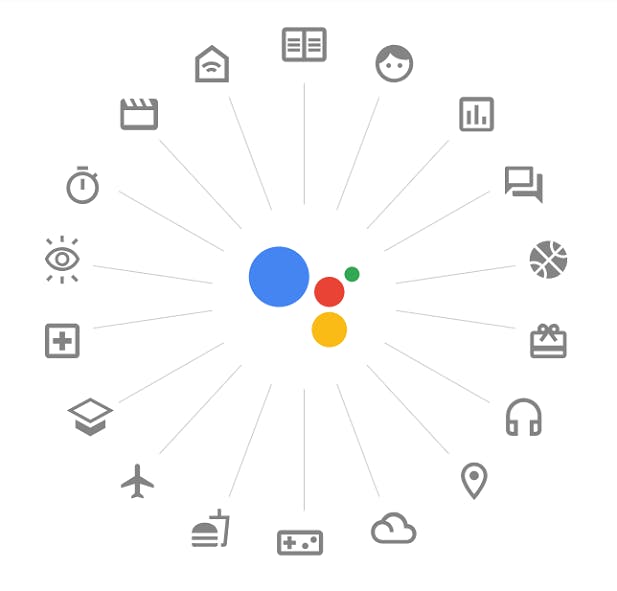Smart speakers are currently a major battleground for the world’s tech giants. Amazon and Google are vying for dominance with multiple variations on the Echo and Home; Apple launched the HomePod earlier this year; and Baidu debuted three different smart speakers at this year’s Consumer Electronics Show.
Facebook also plans to launch its own smart speaker later this year, in spite of delays; Samsung is bringing out a smart speaker with its new digital assistant, Bixby; and most recently, rumours have surfaced of a Cortana-powered smart speaker in the works from Microsoft.
In other words, everyone who’s anyone in the technology industry has a smart speaker.
But does the initial lacklustre showing from Apple’s HomePod mean Apple will struggle to catch up to its rivals? Let’s take a look at how the HomePod’s capabilities compare to its main competitors, from the perspective of both brands and consumers, and what it means for Apple’s long-term prospects in the smart speaker market.

Great on speakers, light on features
The overall consensus on Apple’s HomePod from tech pundits is that it does the “speaker” half of “smart speaker” extremely well – but falls down on the “smart” side.
The sound quality is unquestionably good, with an array of tweeters, microphones and a large woofer (my rudimentary Googling tells me that’s a good thing) to impress any audiophile. But where the Echo and Home could be described as smart assistants that come with a speaker, Apple’s HomePod is a speaker that comes with an assistant – barely.
Apple has played up the sound and music capabilities of the HomePod in its marketing, which makes sense for the company which created the iPod, iTunes and Apple Music. According to Bloomberg, the HomePod originally started out as a side project from a group of Mac audio engineers who “wanted to create a speaker that sounded better than the ones sold by the likes of Bose, JBL and Harman Kardon”.
However, indecisiveness stymied the project, as its creators struggled to decide where the HomePod would fit into Apple’s ecosystem. Meanwhile, Amazon launched the Echo in 2014, and quickly set about reshaping consumers’ expectations for what a smart speaker could do.
By the time the HomePod was finally ready to launch in early 2018, the market that Apple was selling it in looked completely different. Both Amazon and Google had developed sophisticated smart speakers with voice assistants that responded to a range of commands, and which boasted dozens of third-party integrations, allowing users to do anything from order groceries to book an Uber.
Apple has played up the sound and music capabilities of its HomePod smart speaker, but there’s not a lot else that it can do.
Meanwhile, HomePod owners are restricted to playing music (and only if they have an Apple Music subscription, though it’s also possible to stream Spotify over AirPlay using an iPhone or iPad), sending instant messages, creating lists, and setting reminders.
The HomePod’s Siri can also answer basic questions (e.g. “Who is Elon Musk?”) using information drawn from Wikipedia, but appears to have no freeform web search functionality, and will respond to questions aimed at triggering an internet search with, “Sorry, I can’t search the web here”.
This effectively locks Apple out of one of the biggest emerging frontiers for voice search and digital assistants: smart home devices.
Clearly, opportunities for brand marketing via the Apple HomePod are limited at the moment. But for consumers who don’t have a marketing or tech background, does the HomePod present a better prospect than those of us in the industry might appreciate?
The prospects for brands and consumers
At the time of writing, the HomePod is compatible with around twenty different third-party apps. Apple began asking developers in November 2017 to create Siri apps that would work with HomePod – but only messaging, list and notes apps. So far, there’s no word on whether it plans on expanding this remit.
For brands looking to reach consumers through their smart speakers, this means that Amazon Echo and Google Home are much more attractive options. In the four years since Amazon launched the Echo, the device has racked up more than 15,000 ‘skills’, with brands from McAfee to the BBC, Just Eat to NASA creating integrations that bring their products to the Amazon Echo.
Google has been slower out of the gate with third-party support for the Home, but recently threw its whole weight behind increasing the availability of ‘Actions’ (the Google Home equivalent of ‘Skills’), launching a directory in January that boasts more than a million Actions for the Google Home.

Google is encouraging developers to create Actions for the Google Assistant, boasting “a solution for every vertical” (Image: Google Developers)
The ability to search the web with Alexa or Google Assistant also makes the Home and Echo more appealing to brands from a discoverability perspective – well, as long as their answer engine optimisation is up to scratch (and marketers meet the ‘eyes-free Search Quality Rating Guidelines‘).
However, the Apple HomePod isn’t designed to help search marketers. And while it might seem like an obviously inferior offering to those of us who are well-versed in the tech industry (and know what’s possible), we should also consider the HomePod’s appeal to non-techy consumers.
After all, your average punter doesn’t need to do a million different things with their smart speaker. What if they just want to listen to music?
Except… the HomePod falls down there as well. Apple’s rigid insistence on making the HomePod compatible only with its own ecosystem locks out a huge part of the music-loving world. The appeal to hardcore Apple fans is obvious, but if you listen to Spotify (or Prime Music) and don’t have an iPhone or iPad, or if you listen to Apple Music through an Android phone, you can’t enjoy it on a HomePod.
Even as an offering for audiophiles, the HomePod is noticeably lacking: there’s no wired audio input, no Bluetooth streaming, no Ethernet port or A/V device compatibility. For serious music fans who aren’t as bothered about the smart features, there are still much more flexible options out there.
Engadget’s Senior Editor Dan Cooper describes the HomePod as “little more than a gussied-up accessory for a music streaming service”. And, by all accounts, an accessory is all that Apple intended it to be. But even for a high-end item not designed for the mass market, the HomePod appeals to a very limited audience.
Where can the HomePod go from here?
So, is Apple out of the smart speaker race just three months after entering it?
There are signs that Apple might be looking to build on the HomePod’s smart capabilities and develop it into a more serious competitor. Thinknum noticed a spike in the number of job openings available to work with Siri, almost all of them calling for software engineers – suggesting that Apple wants to make its voice assistant a lot smarter.
Add to that the fact that last month, Apple snapped up Google’s former head of artificial intelligence, John Giannandrea, who helped Google to become a market leader in AI, and it’s clear that Apple still has big plans in store for Siri.
What that will mean for the HomePod remains to be seen; depending on how long Apple takes to overhaul its AI offering, it may have lost any hope of edging its rivals out of the market.
But Apple has managed to turn around disappointing product launches before. The Apple Watch, once considered a complete flop, has come back into its own, selling eight million watches in the final quarter of 2017, the highest number since the product was introduced (and more than the entire Swiss watch industry combined).
Then again, Apple has also previously tried and failed to launch a high-end speaker with a $350 price tag and limited compatibility: the iPod Hi-Fi, which was released in 2006 – and discontinued the following year.
Either way, while the world waits for Apple to get its act together, there are plenty of other smart speaker options out there, both for brands and for consumers, to take advantage of.
For more on voice search, subscribers can read Opportunities and Challenges for Marketers in 2018.

Comments